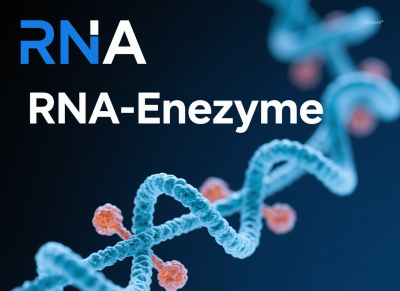RNA Primer: Definition and Function
A RNA primer is a short RNA sequence that provides the 3′-OH terminus required for DNA polymerase to initiate synthesis during DNA replication, PCR amplification, or reverse transcription. Since DNA polymerases cannot synthesize DNA strands de novo (lacking priming ability), RNA primers are essential for replication initiation.
- DNA Replication: In eukaryotes, primase synthesizes RNA primers (~10 nt), which are later extended by DNA polymerases (e.g., Pol α/δ/ε). Post-replication, RNA primers are excised by RNase H or FEN1 and replaced with DNA to maintain genomic integrity.
- PCR: Synthetic DNA primers (not RNA) are more common, though RNA primers may be used in specialized reactions.
- Reverse Transcription: Retroviruses (e.g., HIV) exploit host tRNAs as primers to initiate cDNA synthesis.
Biological Significance
The transient and removable nature of RNA primers prevents DNA strand breaks while ensuring high-fidelity genetic transmission via a “primer replacement” mechanism.
Prime Editing: A Next-Generation Gene Editing Tool
Principle and Innovation
Prime Editing, an advanced CRISPR-Cas9 derivative, achieves precise gene editing by integrating:
- Nickase Cas9 (nCas9): Cleaves only one DNA strand, minimizing double-strand break risks.
- pegRNA (Prime Editing Guide RNA): Contains target-specific sequences and an RNA template to direct new DNA synthesis.
- Reverse Transcriptase: Synthesizes DNA using pegRNA as a template, enabling direct insertion at the target site.
Advantages
- Enables precise base insertions, deletions, or substitutions (e.g., single-base edits or short insertions).
- Eliminates donor DNA templates, reducing off-target effects.
- Applicable to non-dividing cells, broadening therapeutic potential.
Example: Corrects point mutations in sickle cell anemia or repairs cystic fibrosis-associated genes.
NanoRNA Priming: Small RNA-Mediated Transcriptional Activation
Discovery and Mechanism
In bacteria, NanoRNAs (2–5 nt small RNAs) regulate gene expression via:
- Transcriptional Priming: RNA polymerase (RNAP) uses NanoRNAs as primers to initiate transcription of specific genes, enhancing promoter activity.
- Global Regulation: Modulating NanoRNA abundance coordinates stress-response or metabolic pathway genes.
Biological Implications
Reveals a novel role for small RNAs in transcriptional regulation, offering potential targets for anti-infective therapies or synthetic biology.
Commercial Reagents and Tools
Prime RNase Inhibitor
- A non-human-derived ribonuclease inhibitor that neutralizes RNase A/B/C activity, safeguarding RNA stability in experiments (e.g., RT-PCR, in vitro translation).
- Features: Broad pH tolerance (pH 5–8), high stability (resists DTT and temperature fluctuations).
RNAprime™ (Eppendorf)
- Protects RNA from degradation during in vitro translation (e.g., yeast extract systems), ensuring accurate protein synthesis.
Other Key Concepts
PrimPol Enzyme: Dual Functionality
- Combines primase (synthesizes RNA/DNA primers) and DNA polymerase activity, aiding DNA damage repair and mitochondrial genome maintenance.
- Prefers dNTPs for primer synthesis, bypassing RNA excision steps to enhance replication efficiency.
Bioinformatics Annotations
- primer_bind: Marks primer-binding sites on DNA/RNA (e.g., for replication or PCR targeting).
- prim_transcript: Denotes unprocessed initial RNA transcripts (e.g., pre-mRNA).
Summary and Key Terms
| Term | Definition | Applications |
|---|---|---|
| RNA Primer | Short RNA initiating DNA synthesis | DNA replication, PCR, reverse transcription |
| Prime Editing | RNA-templated precision gene editing | Genetic therapy, functional genomics |
| NanoRNA Priming | Small RNA-driven transcriptional activation | Bacterial gene regulation |
| Prime RNase Inhibitor | RNase-blocking reagent | RNA protection, in vitro assays |





RNA Primer(RNA引物)
RNA引物 是一段短链RNA分子(通常5~10个核苷酸),在DNA复制或逆转录过程中作为起始合成的“起点”,由引物酶(如Primase)合成。它提供游离的3′-OH末端,供DNA聚合酶延伸DNA链。
核心功能与特点
DNA复制中的角色
原核生物:RNA引物由DnaG合成,启动后随链(Lagging strand)的冈崎片段合成。
真核生物:由DNA聚合酶α-Primase复合体合成,用于前导链和后随链的起始。
最终被移除:RNA引物会被DNA聚合酶I(原核)或RNase H/FEN1(真核)切除,并由DNA填补缺口。
逆转录中的角色
逆转录病毒(如HIV)以宿主tRNA或病毒RNA片段为引物,启动cDNA合成。
PCR中的类似物
人工合成的DNA引物(非RNA)替代了天然RNA引物,但功能类似。
为什么需要RNA引物?
能量需求:DNA聚合酶无法从头合成DNA链,需依赖引物提供3′-OH末端。
校对机制:RNA引物可被高效切除,减少复制错误5。
应用场景
分子生物学实验
设计DNA引物时需避免RNA残留(如cDNA合成中需用RNase H处理)。
抗病毒药物靶点
阻断HIV逆转录酶的引物结合位点(如非核苷类抑制剂)。